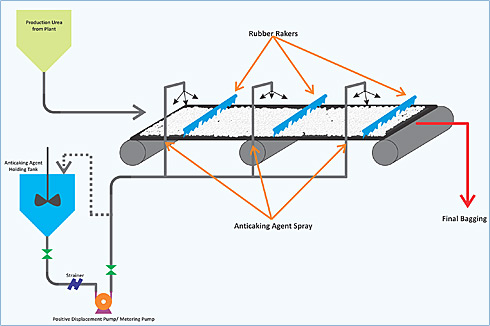| |
|
|
|
|
|
|
 |
|
|
|
|
|
|
|
|
Caking is a process by which a fertilizer loses its desirable free flowing property. We can consider the caking as the agglomeration among prills or granules with tendency to form more or less hard concrete lumps of large dimension and varying mechanical resistance to disintegration.
If disintegration of lumps is only possible by application of strong mechanical forces and / or impact we have the case of a severe or hard caking. In this case disintegration of lumps is difficult and time consuming and usually results in partial destruction of the particles (formation of fines and dust). Caking is light if lumps disintegrate relatively easily to free flowing condition again, practically without dust or fines formation.
Caking of urea is caused by formation of crystal bonds between particles: Internal moisture or externally absorbed water is, by capillary or thermal action forces attracted to the contact surface of the particles. Saturated solutions will be then formed at the particle surface attracted by capillary adhesion to the contact area. Due to temperature increase of urea as a result of thermal action, water in the liquid phase can evaporate, and by crystallization process crystals are formed at the contact area of the particles, creating a more or less strong bond between them. |
|
|
|
|
|
 |
|
|
Dosing of Urea Anticaking Agent |
|
|
|
|
|
Main parameters minimizing urea caking
We will first consider the case of urea produced in hot and humid climates and conveyed immediately to an appropriate bulk storage, without air conditioning or air dehumidification, where ingress of large volume of humid air is restricted by keeping storage doors closed. We also consider loading from storage into the hatches of an ocean going vessel, as well the unloading at the designation port.
To prevent caking itself, or minimize consequences of caking in a prilled urea bulk storage, where ingress of large volume of humid air is restricted by keeping storage doors closed following main conditions must be satisfied. |
|
|
- Low moisture urea content 0.15 to 0.25%
- Sufficiently hard prills with prill strengthening agent
- Round, possibly uniform size prills, without fines, dust of minimum contact surface, by using appropriate prilling device
- Maintaining temperature of the urea going to the bulk storage, as close as possible to the storage ambient air temperature
|
|
|
Anticaking treatment of the final product
Physical properties of fertilizers are important in processing, handling, bagging, transportation, storage and applications.
By and large, hygroscopicity of the fertilizer is important when considering conditions under which a bulk file can be stored and material flow ability during handling and field application. Fertilizers materials vary in their ability to with stand physical detoriaration when exposed to humid atmosphere. Critical relative humidity is a very important parameter at the same time other parameters such as weight of moisture adsorption, depth of moisture penetration, moisture holding capacity and the integrity of weighted granules.
In spite of the fact that prilled urea having the physical properties specified above has good handling behavior, it is considered to be inferior to granular urea for bulk shipment in ocean going vessel and loading- unloading operations in humid climates. To improve further the handling properties of prilled urea, usually a light dosing (300 to 500 ppm), of an anticaking agent for external superficial treatment of the finished product helps. This agent is often a sophisticated compound of surfactants and soluble polymers.
Urea Anticaking Agent:
Taking in to consideration the above parameters FERTIBON PRODUCTS have developed Water based Anticaking Agent for Urea. This product is homogeneous clear solution and can be easily sprayed on to the urea moving on conveyor belt. The product is sprayed on two or three locations on the belt with rubber rakers to provide mixing after each spray. The product is non rubber reactive and easily sprayed on to the urea moving on the belt. A separate Technical data Sheet is enclosed. Typical flow sheets vide Fig. 11 gives the actual dosing system. |
|
|
|
|
|
TOP |
|
|
|
|
|
|
|
|
| |
|
|
